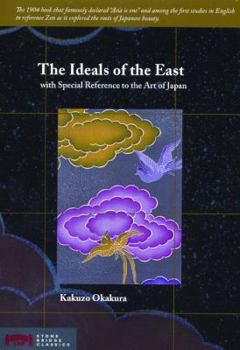The Ideals of the East: With Special Reference to the Art of Japan
Select Format
Select Condition 
Book Overview
Written by the foremost authority of the era on Oriental archeology and art, this extremely influential book offers a brief but concise introduction to Asian art. First published in 1883, it responded... This description may be from another edition of this product.
Format:Paperback
Language:English
ISBN:1933330252
ISBN13:9781933330259
Release Date:April 2007
Publisher:Stone Bridge Press
Length:152 Pages
Weight:0.30 lbs.
Dimensions:0.4" x 5.4" x 7.5"
Customer Reviews
1 rating
A poetic look at Japanese art and religion
Published by Thriftbooks.com User , 15 years ago
Kakuzo Okakura, author of the legendary The Book of Tea, was a first-hand witness to the rapid changes of the Meji period, when the closed nation of Japan had its locked doors forced open by the US military, and was suddenly thrust onto a world stage of which it had previously chosen to decline. Okakura was first and foremost a scholar; a member of the Imperial Art Commission, Okakura had been sent abroad in 1886 to study the artistic development of Europe and the US and to see how that compared to Japan's own development. Upon his return, Okakura saw a need for a book in English explaining Japan's artistic foundation, the religion and cultural elements that shaped that foundation, and how changes across the centuries had been paralleled by artistic development. First published in 1904, "Ideals of the East: The Spirit of Japanese Art" is that book. Beginning in the pre-history of The Primitive Art of Japan, and following through such things as Confucian and Buddhist influences, the book then ranges through the Asuka period, the Nara, Heian, Fujiwara, Kamakura, Ashikaga, Toyotomi and Tokugawa periods before finishing in Okakura's own Meiji period. Instead of a straight history of art, Okakura discusses the ideals of each period, the various religious beliefs and the political forces that shaped Japanese art. Rarely have I seen such a small book packed with so much information. At only a hundred and six pages, Okakura ranges over a thousand and more years of history. Like a skipping stone flashing across a deep ocean, Okakura touches down in each era only long enough to give the true essence of the art created then without superfluous details or a listing of major works and artists. This book is, after all, about the "Spirit of Japanese Art" and not a lesson on the art itself. Because he was a scholar, and writing for other scholars instead of the general public, Okakura presumes a familiarity on the part of the reader with Chinese and Indian art history, with important Asian art movements and the religions of East Asia. His language is in the style of the time, verbose and poetic rather than academic. Sometimes it seems like his sentences are flights of fancy and speculation, but there is a great depth inside his words. "Ideals of the East: The Spirit of Japanese Art" is not going to be a book for casual readers. One should have a decent background in Japanese history and Eastern religions to truly get the gist of what Okakura is trying to tell. Because he skims over topics that he thinks the reader would already know, coming to the book cold might be a bit overwhelming. But if you are familiar with the topic, the book will enrich more dry, academic studies with the true passion Okakura felt for the artistic achievements of his native land. One interesting side note: Almost no attention is paid to what has become the modern image of Japanese art, the ukiyo-e prints. Although Okakura recognizes their beauty, he writes that he is a






